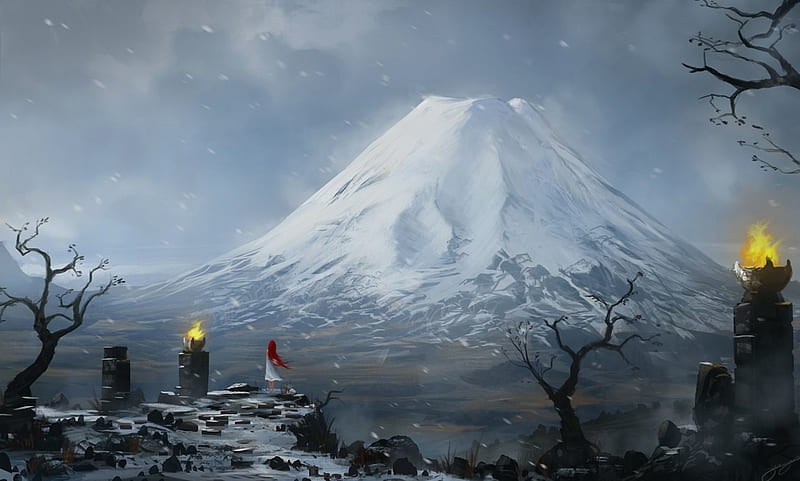Teskaryn
Teskaryn rises from the frigid southern seas like a continent still in the process of becoming—its edges jagged, its stone young and steaming. Caught between glacial winds and volcanic heat, it is a land of contradictions: frozen tundras veined with magma, obsidian badlands scorched by steam, and fjord-carved coastlines haunted by ash-stained cliffs. Teskaryn is the southernmost major landmass of Sitagus, but unlike the unified bulks of Falthrim or Zegaath, it is a scattered continent—a fractured ribbon of islands, peaks, and volcanic spines strung across a continental arc like beads cracked from a titan’s necklace.
Though broken into many bodies, Teskaryn is not disjointed. Beneath the waves, these islands share the same tectonic skeleton—a volcanic shield continent, partially submerged, coalescing along a horseshoe-shaped subduction trench that marks the deepest scar of the southern ocean. From orbit or prophecy, it appears as a long, curving scythe—a seafloor suture that never healed.
This land, if it can be called one, is the youngest of Sitagus’s continental plates, born from tectonic rebound in the wake of the Strike of Signus. Where once there was only seafloor and steam, land rose in violent pulses—spitting fire and stone, and growing by inches each year. Even now, the ground murmurs beneath one’s feet. New islands emerge along the southern fringes; others vanish beneath rising tides or collapse into the boiling sea. It is a continent still forming, its bones raw and uneven, its people shaped by fire, cold, and the need to endure.
Most of Teskaryn’s larger islands—some wide enough to host inland basins, some long and narrow like mountainous spines—are separated by deep straits and subarctic channels, but during long winters, the temperatures drop low enough that ice bridges naturally form. For weeks or months at a time, these waters freeze solid, becoming transitory roads for traders, nomads, and migrating beasts. It is said that some of the northernmost tribes can walk from one volcanic island to the next without ever touching a boat, pulling sledges over black ice studded with steam vents and frost-fanged crevasses. In warmer seasons, the channels melt, forcing a return to cold-weather sailcraft, ferries, and geothermal submersibles designed to navigate the heated underflows.
Teskaryn’s inland regions—when such a term can be used for islands—are defined by volcanic plains of black basalt, geyser fields, fumaroles, and deep geothermal vents. The terrain alternates between jagged lava flows, windswept tundra, moss-choked craters, and glacial rift valleys. In the warmer pockets where magma runs close to the surface, geothermal cities have been carved into stone fortress settlements that use earth-heat to power forges, greenhouses, and hydrothermal engines. These cities are fiercely self-sufficient, often fortified, and protected by insulated war-clans who trade obsidian blades, rare minerals, and thermal artifacts with distant northern powers.
The coastlines, especially along the western curve and southern arcs, are carved into dramatic fjords and cliffside harbours, born of both glacial retreat and tectonic upheaval. Sea-faring cultures thrive here—weather-hardened traders, whale-hunters, frost-sail clans, and thermal salt-miners—who navigate between jagged island chains and steaming vents. Their ships are built narrow and long to cut through icy waters and fog-choked reefs, with reinforced keels that can survive sudden freeze-overs or boiling shallows. Many of these people inhabit archipelagic provinces, tied not to fixed borders, but to island currents, migratory fishing routes, and volcanic flow patterns.
In the northern ranges of the chain, ore-runner nomads cross shifting ice plains and jagged cliffs, herding frosthorn beasts and mapping quake-safe paths between geothermal strongholds. Their gear is lined with obsidian filaments for insulation and sparking flint, and their lore is sung in seismic rhythms, interpreting tremors as omens from the underworld. Some dive deep into ancient lava tubes, seeking the metals and memory-stones left behind by civilizations that rose too close to the heat and fell into silence.
Teskaryn’s magic is not delicate. It is elemental, retributive, and unshaped. The continent resonates with Greenweave fire, volcanic ley pulses, and geothermal lifelines. Obsidian forges, ancient as any cathedral, hum with residual power, and flamebound smiths are said to shape not just metal, but stone-willed weapons—tools that carry a fraction of the continent’s wrath.
"Our land does not break. It cools. It sleeps. And one day, it will rise again and remember."
— Ghar-Lishta of the Iceflame Forge, Highsmith of Teskaryn


Comments